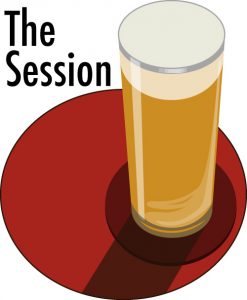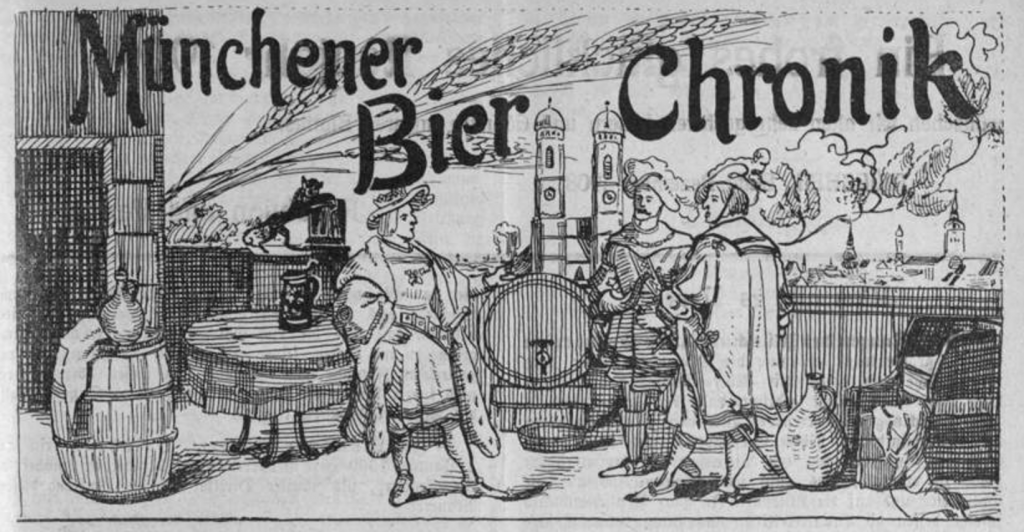This is my contribution to Session 120.
Bavaria is seen as a heartland of German beer culture, and people usually associate it with pale, sparkling, malty lager beers served in glasses way too large to comfortably lift and drink from. Dark beers are still around and brewed by the Munich breweries, usually referred to as “Munich Dunkel” in modern beer style guidelines, but they’re not fashionable anymore and more of a niche drink for connoisseurs. But this didn’t use to be like that: brewing pale lager was initially only done for export, to counter the fashion of Pilsner beers. Until the 1930’s, dark lager beers were still the most commonly consumed beer style in the Bavarian capital. Even Radler, many people’s favourite summer refreshment, a mix of about half-and-half beer and lemonade, was originally mixed using dark lager beer. And I can absolutely recommend to try a Radler made like that (in a good beer garden, simply ordering a “dunkler Radler” shouldn’t be a problem), the malty notes compliment the lemony tang more nicely than Helles.
So, how was such a beer brewed back then? As for most parts of Bavaria, beer in Munich was traditionally brewed using a decoction mash. As a base malt, a dark, melanoidin-rich 2-row malt, nowadays commonly known as “Munich malt”, is chosen: it produces a dark wort, but should ideally be neither roasted nor smokey.
When looking at historic sources, strength differs, of course, but let’s pick a recipe from the 1830’s: with an original gravity of 16 °P (1.065), it would nowadays be considered to be of Starkbier strength, and called a Bock, but lager yeast used to attenuate terribly (sometimes as low as 44 %, often as high as 55 to 65 %), so we can expect 5.3 % ABV using a modern, low-attenuating lager yeast.
The important bit about brewing this beer is the process, though: using a single-step infusion mash won’t get you there. You need to decoct.
Starting with 5.25 kg of Munich malt to produce about 20 liters of beer, dough in the milled grain with 18 liters of cold (~10 °C/50 °F) liquor (i.e. water), and let it rest for 4 hours. Then slowly mix in 9 liters of boiling liquor to raise the temperature to 40 °C.
Then take 9 liters of thick mash (you can just ladle out from the bottom of your mash tun), slowly bring it to a boil over the course of one hour, boil it for one hour, and then again slowly mix it back into the mash tun. This should raise the mash temperature to 55 °C.
Again, draw 9 liters of thick mash, bring to boil and boil for 30 minutes, then slowly mix it back into the mash tun. This should raise the mash temperature to 67 °C.
For the final decoction, draw 9 liters of thin mash, bring it to a boil, boil for 15 minutes, and slowly mix it back into the mash tun until it has reached a temperature of not more than 75 °C. Then rest for 1 hour.
After that, you can start lautering and sparging, until you’ve collected about 28 liters of wort.
Add 120 g Bavarian or Bohemian hops (3 % alpha acid), e.g. Hersbrucker, Spalter, Hallertauer Mittelfrüh or Saazer, to the first wort, and bring it to a boil. Boil for 2 to 2.5 hours. The calculated bitterness is 44 IBU, but much of this bitterness will age out and get smoother during lagering.
For fermentation, chill the wort to 8 °C. Pitch a healthy starter of lager yeast (in my experience, WLP820 comes close to the bad attenuation of historic yeast strains), and ferment the beer at 9 to 10 °C.
If you want to be extremely authentic about lagering, get a wooden, pitched cask of about 20 liters size, fill your beer into it, bung it up, and let it mature for 8 to 10 months. Alternatively, you can leave the pitch out and just use a metal keg or beer bottles.
The resulting beer should be sparkling, brown, malty, not too bitter, and contain about 5.3 % ABV.
If you want to check the historic sources for this beer yourself: this recipe is taken from the book “The Art of Brewing” by David Booth, published in 1834.
The resulting beer may not be cool, neither in the hip beer scene nor in the conservative Bavarian beer culture, but it’s nevertheless a great beer style. If you’re too lazy to brew it yourself (which is understandable, the recipe implies an extra-long brew day), here’s my suggestion for a fantastic example of the style: Augustiner Dunkel. At 5.6 % ABV, it is spicy, malty, with hints of chocolate and licorice, but never sweet.


